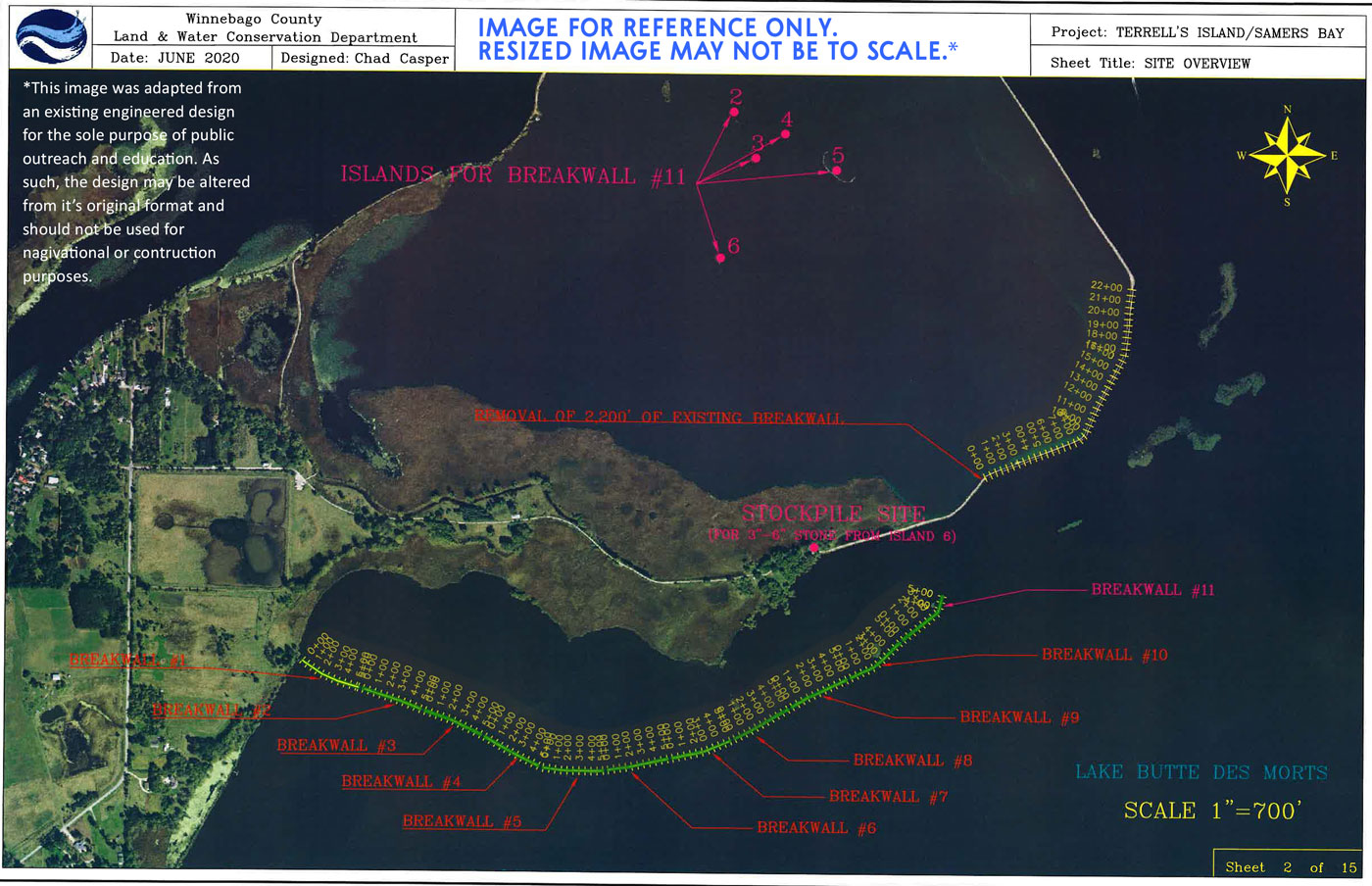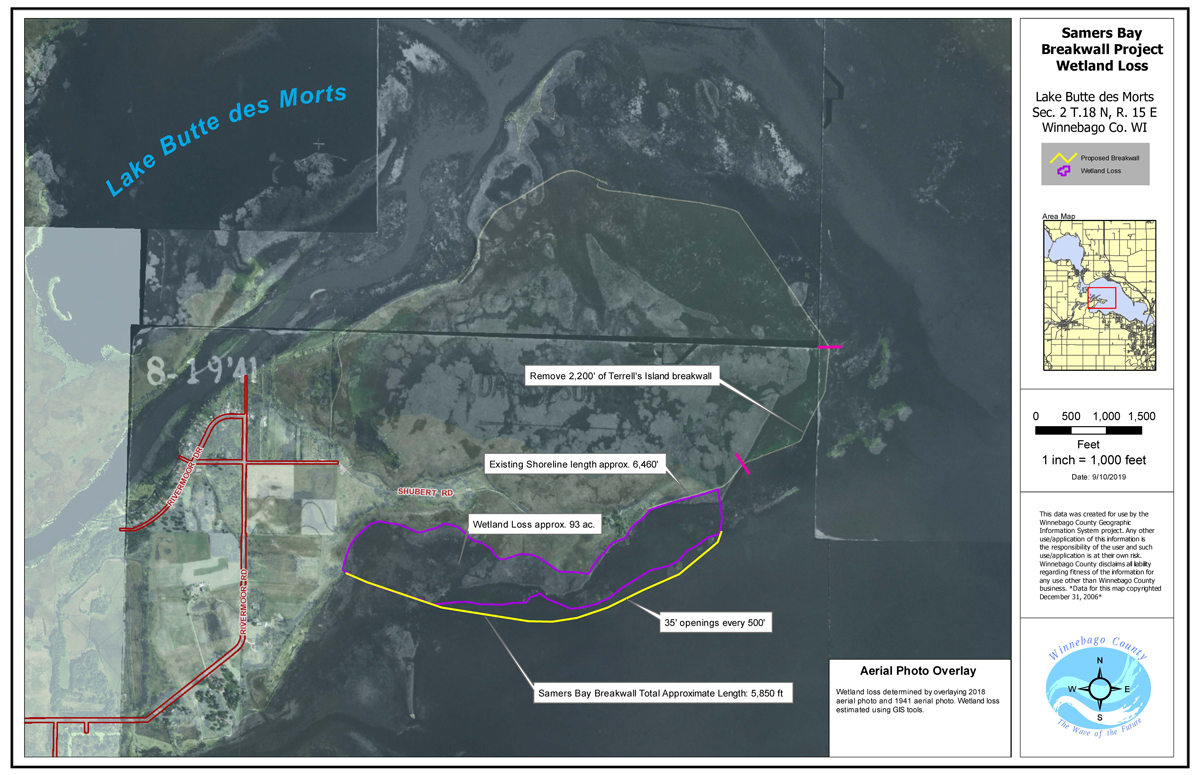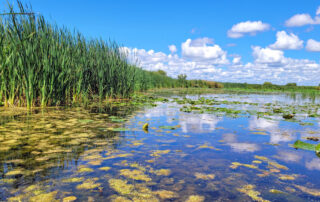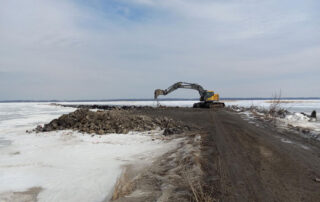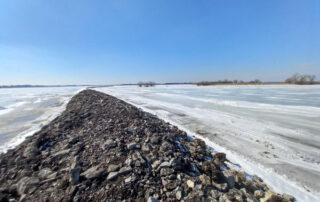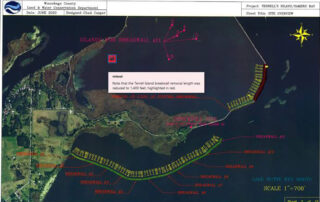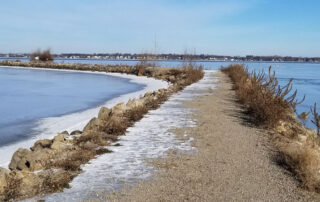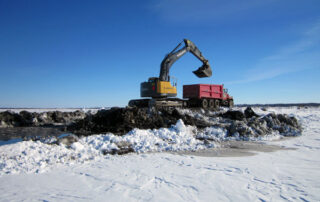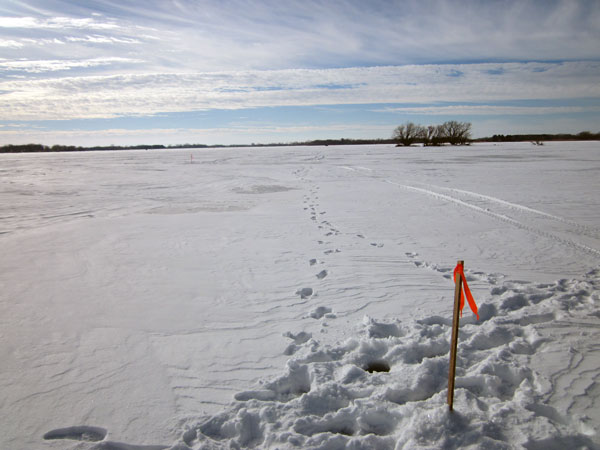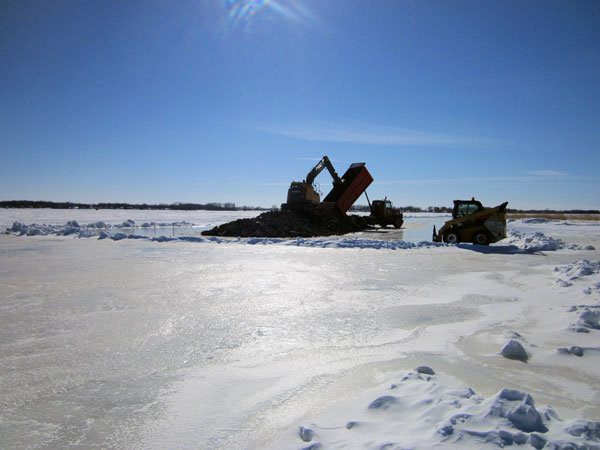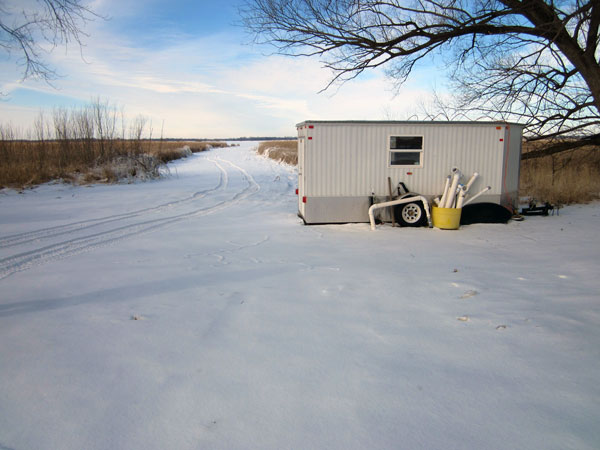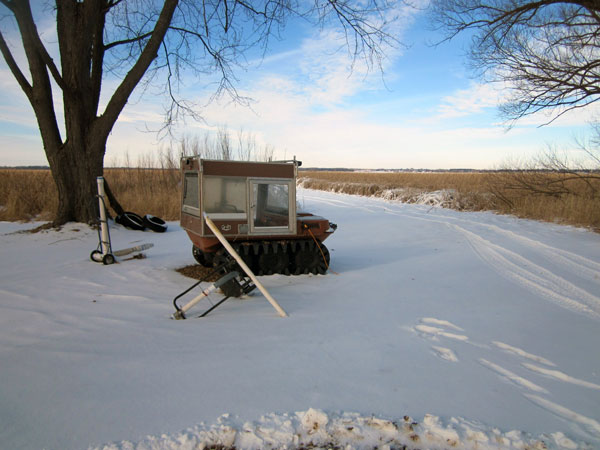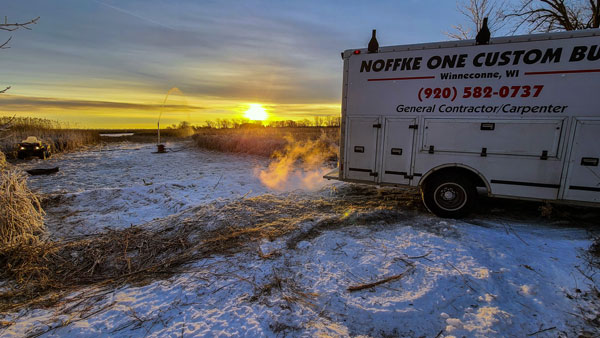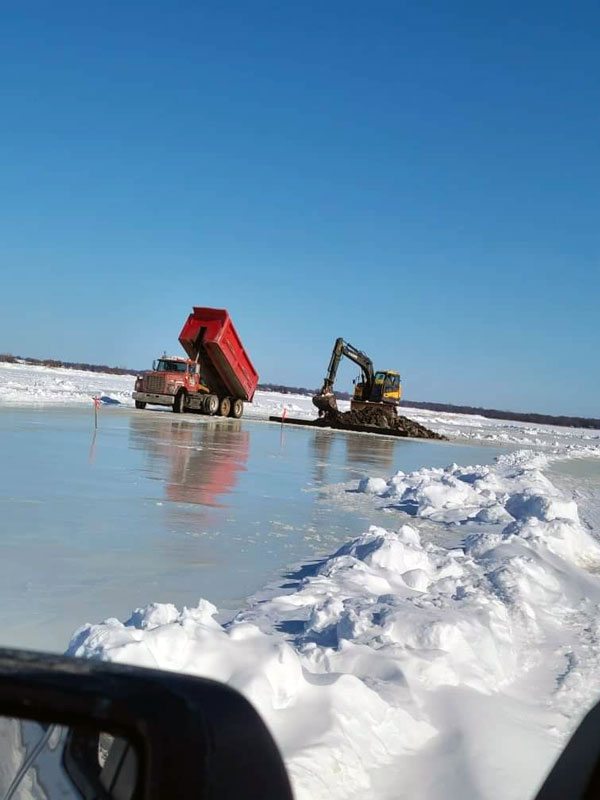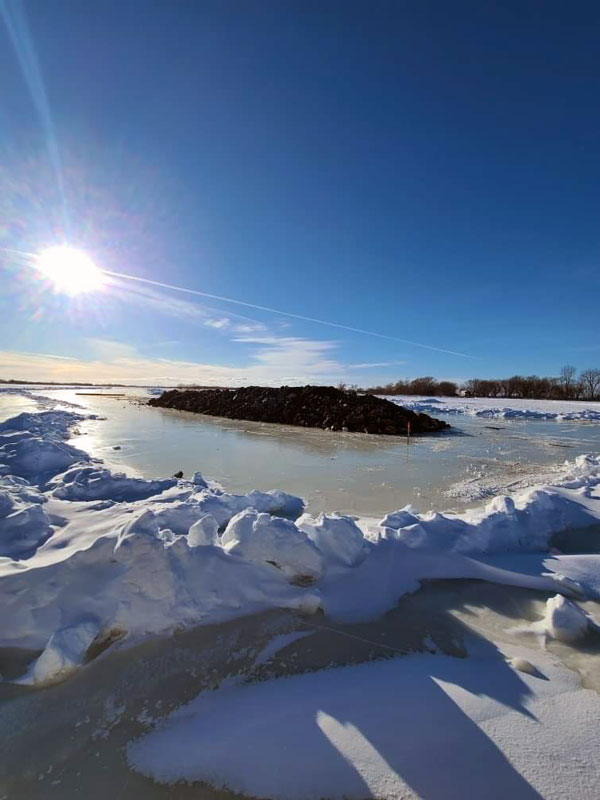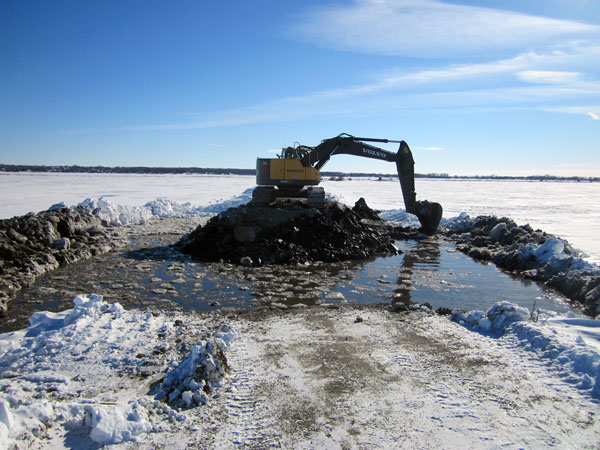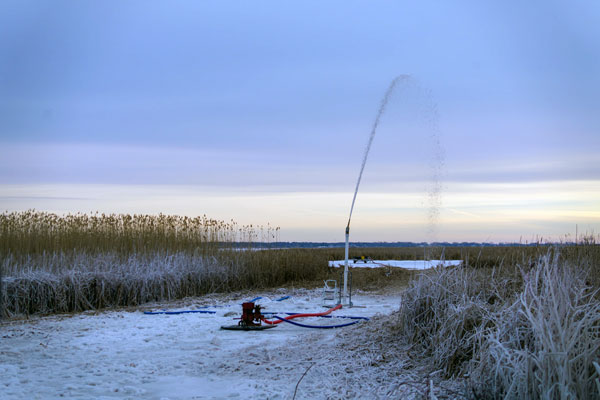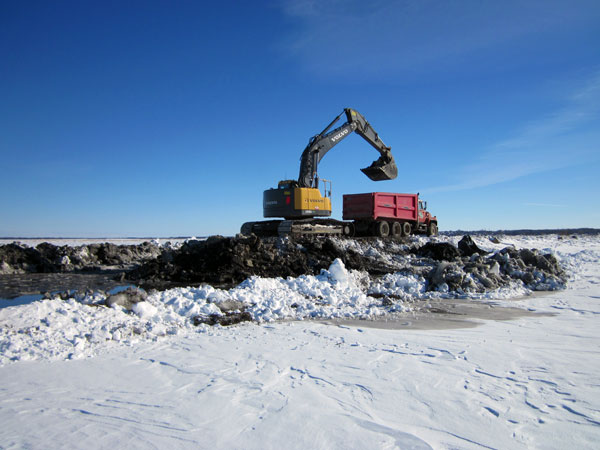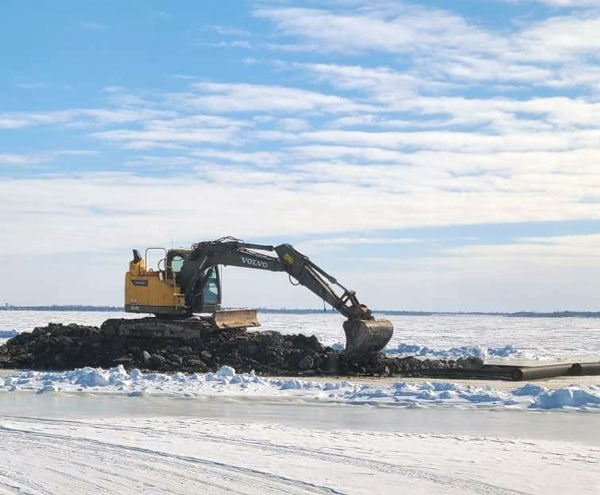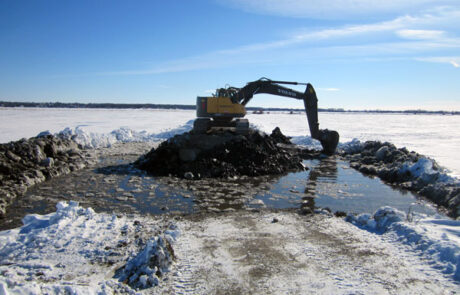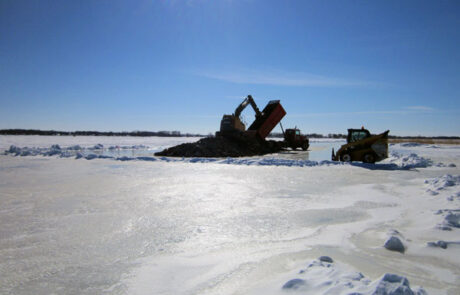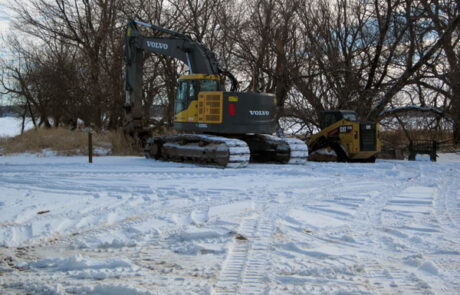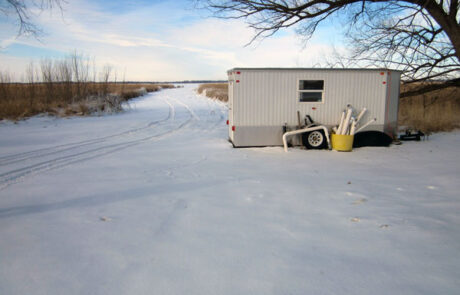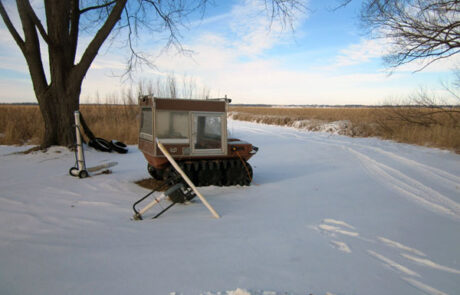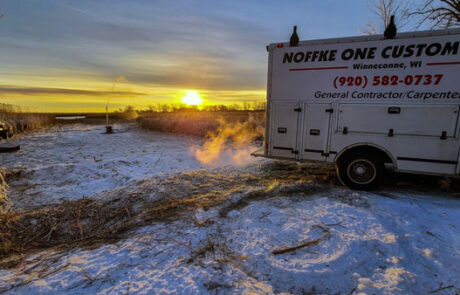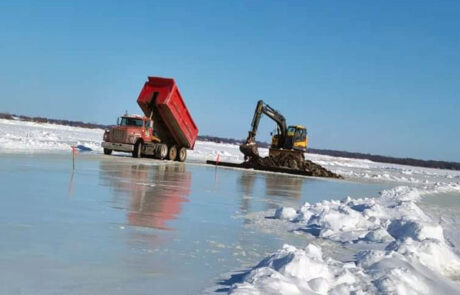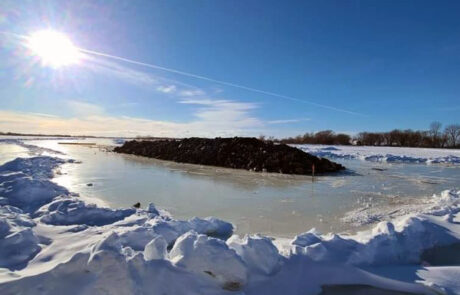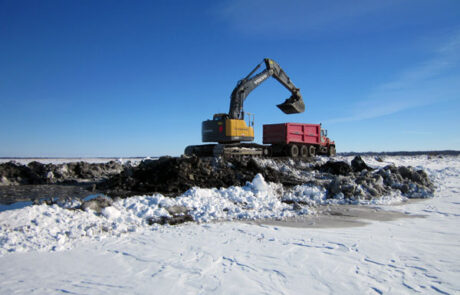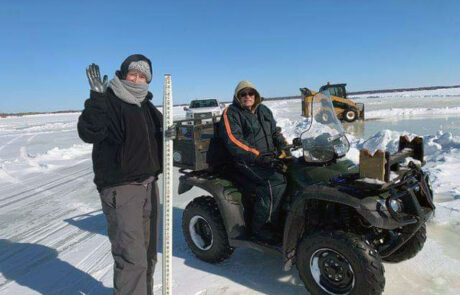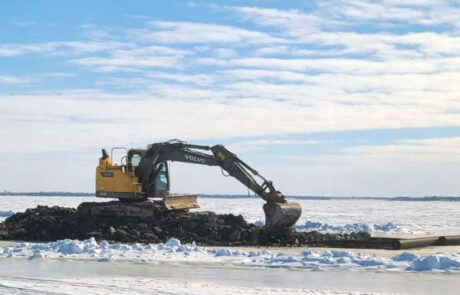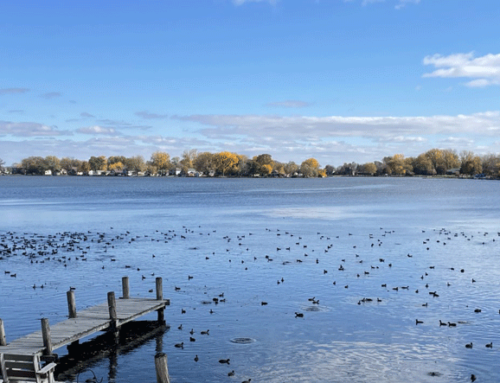Terrells Island and Samers Bay Project Overview
Fox-Wolf Watershed Alliance (Fox-Wolf), Butte des Morts Conservation Club (BDMCC), Winnebago County (WC), and the Wisconsin Department of Natural Resources (DNR) partnered on a large-scale restoration project to improve water quality and habitat in Lake Butte des Morts. The project team secured over $1 million to fund the project that broke ground in January of 2021. Construction is anticipated to be completed in winter of 2024 (depending on ice conditions). This project will restore ~680 acres of wetland and aquatic habitat.
The restoration has two main objectives:
- Protect, preserve, and restore ~111 acres of wetland and aquatic habitat on the the north west side of Samers Bay on Lake Butte des Morts.
- Improve water quality and habitat across 569 acres within Terrell’s Island on Lake Butte des Morts.
To meet those objectives, the project was broken down into two funding phases:
Phase 1:
- Remove a 1,400 ft section of existing rock along the east side of the Terrells Island breakwall (reduced from the original plan to remove ~2,200 ft).
- This will create a large opening to improve water circulation and re-connect the area with the larger lake
- Remove rock from five artificial rock islands located within Terrells Island (Islands 2 thru 6).
- Re-use rock removed from Terrells Island to build ~3,000 ft. of a new breakwall along the north west side of Samers Bay.
- To protect an area that is eroding, on average, at a rate of 8 to 9 ft. per year.
Phase 2:
- Complete construction of the remaining 2,850 feet of the Samers Bay breakwall.
- This will create a calm, protected area to re-establish aquatic vegetation.
In summary, when the project is complete, Terrells Island will have a 1,400-foot opening on the east side of the existing breakwall. The rock material removed to create the opening will have been used to build a large portion of the new Samers Bay breakwall. This opening will allow for substantial water exchange between the area inside of Terrells Island and Lake Butte des Morts. The result will be better water quality and reestablished use by desirable fish and wildlife species within the 569-acre Terrell’s Island Habitat Restoration Area. The Samers Bay breakwall will total 5,850 feet in length (~5,200 ft of breakwall with 35-foot openings every 500 ft.) and will restore 111 acres of wetland habitat.
Public Support for Restoration:
The Butte des Morts Conservation Club, WI DNR, and Winnebago County LWCD held two public meetings regarding proposed habitat restoration efforts at Samers Bay and Terrell Island on Lake Butte des Morts. Both meetings were well attended with attendees expressing support for the projects.
CLICK HERE to view the slides from the presentations.
In addition to public meetings, the restoration project has been highly publicized through press releases, local postings, social media, newsletters, websites, and more. Overall, projects partners have received positive feedback with stakeholders acknowledging that the water quality improvements and increased opportunities for wildlife viewing and nature enjoyment will far outweigh changes being made to the existing structure.
Anticipated Outcomes:
Habitat and Water Quality
A key component of these restoration projects is the re-establishment of aquatic vegetation. Breakwalls provide conditions perfect for aquatic plant growth by:
- Reducing the re-suspension of lake sediments which improves water clarity.
- Creating calm areas protected from the turbulent waves of the large, shallow lakes.
The restoration of aquatic vegetation within these breakwall projects will provide nesting, spawning, rearing, and refuge habitat for multiple fish species. Fish species including bluegill, crappie, largemouth bass, and yellow perch will likely benefit the most and should utilize the restored habitat throughout the year. The restoration of vegetation will also provide important spawning habitat for adult northern pike and Great Lakes spotted muskellunge as well as provide refuge for juvenile fishes. Fishery surveys have shown that fish diversity and abundance (particularly Centrarchids) increase when aquatic vegetation is restored.

Source: WI DNR
For example, electrofishing surveys were conducted in 2018 to evaluate the existing Clarks Bay breakwall on Lake Winneconne. Three stations were surveyed to assess fish abundance and population metrics including, the inside of the breakwall along the structure, outside the breakwall along the structure, and a station to the east of the breakwall with natural shoreline. Catch rates for largemouth bass, bluegill, and yellow perch were notably higher inside the breakwall (64.4, 135.6, and 113.3/mile) compared to the natural shoreline station (12.0, 16.0, and 54.0/mile). In addition, bluegills were observed spawning along the rocks on the outside the breakwall along the structure, with a catch rate of 177.1/mile for the station. Therefore, the restoration of aquatic vegetation within new breakwalls should help to continue restoring fish populations.
Wildlife beneficiaries include furbearers, migratory waterfowl, coots, rails, wading birds including American and least bitterns, Foster’s and black terns, bald eagles, and ospreys. Of particular interest is the potential to re-establish migration habitat for diving ducks such as scaup, redheads, and canvasbacks, all of which formerly visited the Winnebago pool Lakes in large numbers during spring and fall migrations.
This project will also reduce the nutrient loading from loafing birds inside Terrell’s Island.
Recreation Benefits
In addition, improving fish and wildlife habitat at Samers Bay and Terrell’s Island will provide better recreational opportunities for the public, including fishing, hunting, canoeing, kayaking and wildlife viewing.
Meeting the Goals of Terrells Island and Regional Plans:
These efforts would help to meet the original goals of the Terrell Island property management plan, including:
- Protection of Lake Butte des Morts and the Winnebago Pool Watershed;
- Protection and restoration of the plant communities and fish and wildlife habitat;
- Allowing public access for recreational purposes.
Learn more at the Butt des Morts Conservation Club’s website: CLICK HERE
This multi-agency and stakeholder project helps the system progress toward habitat restoration and water quality improvement goals outlined in several agency management plans, such as:
Site Information and Recent History:
Historically, marsh and wetland areas located throughout Lake Butte des Morts supported some of the most productive fish and wildlife areas on the Winnebago System. However, deterioration of protective marsh edges and decreases in water clarity since the late 1950s has resulted in dramatic vegetation losses and declining fish and wildlife habitat throughout the Upriver Lakes.
Terrell’s Island was constructed by the WI DNR in the late 1990s. The 15,000 foot breakwall enclosed approximately 600 acres of water with the intention of restoring lost wetland and aquatic habitat and improving water quality. In addition to the breakwall, seven nesting islands were built inside of the enclosure. The years following construction, the enclosed area showed incredible improvements in water quality and habitat. Water clarity greatly increased and desirable aquatic vegetation as well as fish species flourished. Unfortunately, in the late 2000s, conditions within the breakwall began to decline. An excess amount of nutrients from large groupings of certain bird species and a lack of water circulation caused a rapid decline in water quality, periods of low dissolved oxygen, and loss of aquatic plants.
Since the construction of the Terrell’s Island breakwall, several other breakwalls have been built throughout the Winnebago Lakes. Lessons learned from the Terrell’s Island project have been incorporated into breakwall design which has resulted in incredible restoration success. For example, it is now well understood that openings are needed along the length of a breakwall to ensure adequate water circulation.
While there have been many successes in restoration around the Winnebago Lakes, more progress is needed. The Lakes overall continue to suffer from degraded habitat, recession of wetland due to erosion, a lack of aquatic plant abundance, and poor water quality. Restoring and area the size of Terrell’s Island would have significant beneficial impact to the Lake system. Because of this, restoring Terrell’s Island and reusing rock from the restoration to build a new breakwall is underway.
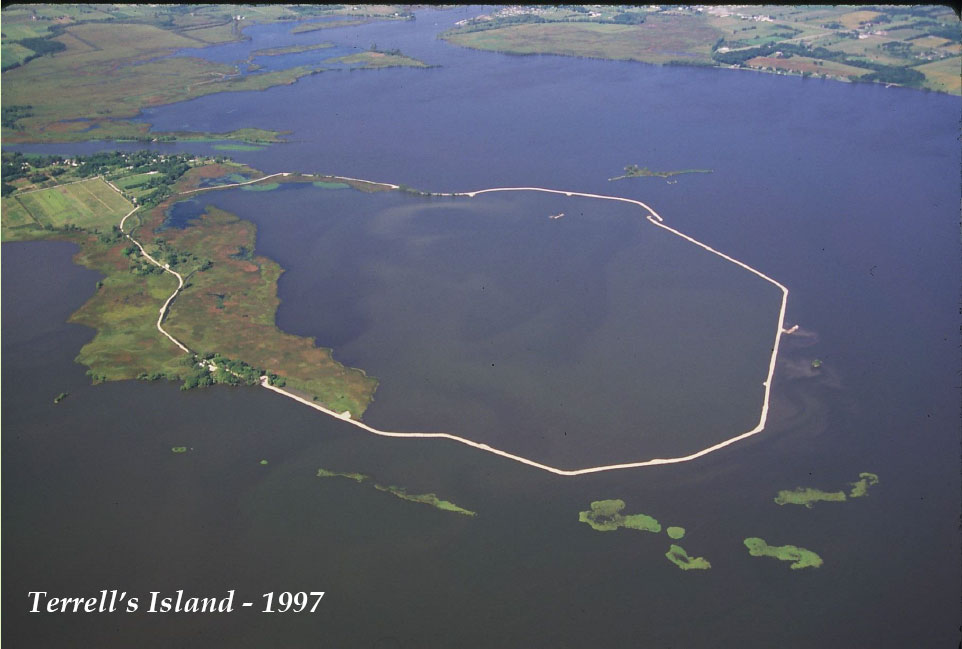
Sign up to receive updates
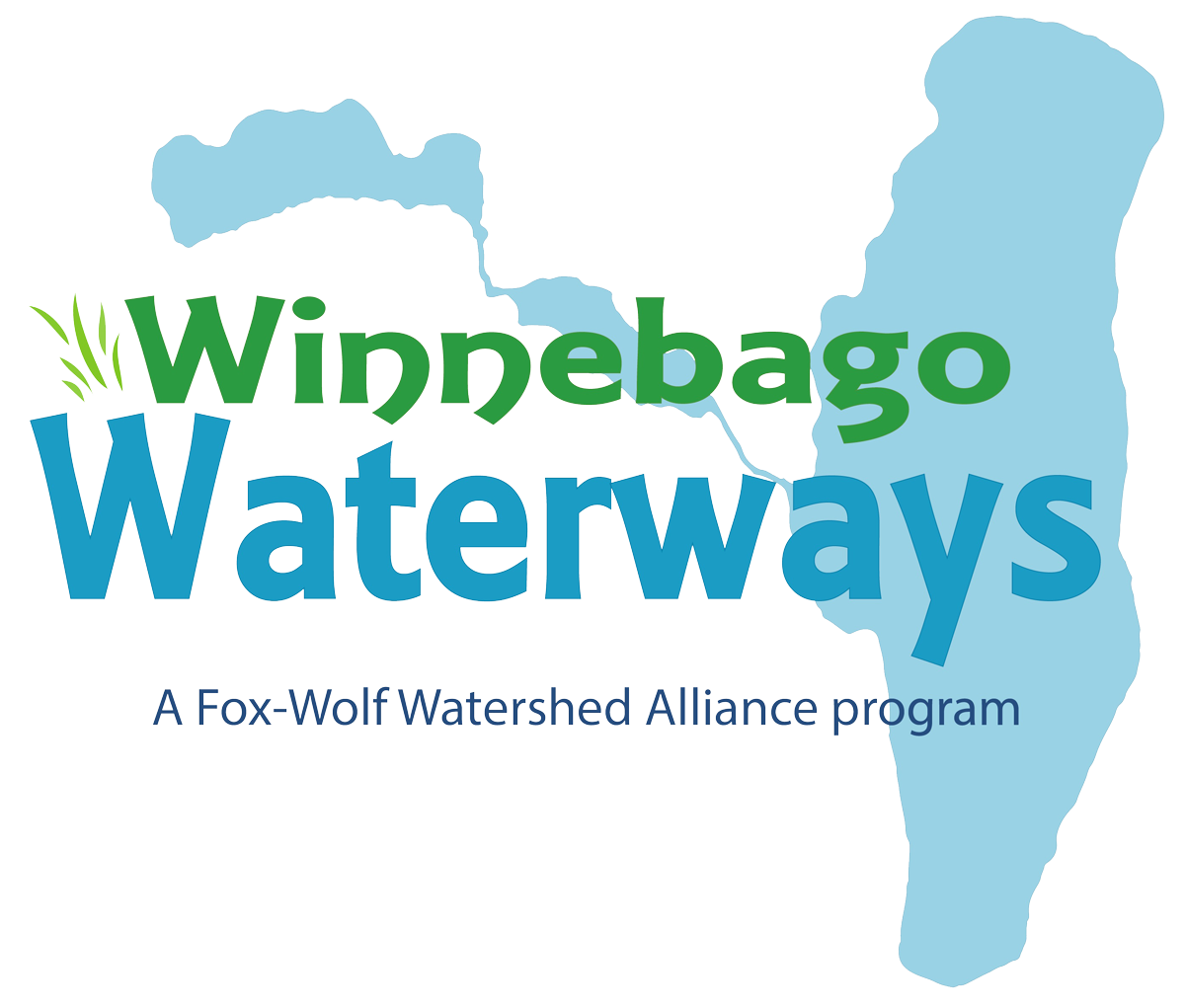
What are off-shore breakwalls?
Off-shore breakwalls are a line of rock riprap located in open water parallel to the shoreline typically adjacent to eroding wetlands. Learn more about breakwalls here: CLICK HERE
Project updates:
Breakwall Installation – Phase 1
Photo Collection
Additional Project Information:
Many Alternatives Explored
Several potential alternatives to leaving a gap in the existing breakwall were explored. Unfortunately, the high costs for installation, ongoing costs of maintenance, high likelihood of annual damage to infrastructure from ice action, risk of failure, and a lack of reliable funding to cover ongoing costs left those options, such as bridges, out of reach. Fortunately, the gap in the breakwall is only a portion of the large property owned, managed, and cared for by the Butte des Morts Conservation Club. Thanks to their generosity and dedicated volunteers, there are still miles of connected area to explore along the lake which will be improved greatly through this restoration initiative.
Funding
In total, the project is estimated to cost approximately $1.2 million. Approximately $1 million has been secured from the NRDA Grant Program ($509,000), the Great Lakes Fish and Wildlife Restoration Act ($185,000), Wisconsin Habitat Partnership Fund ($325,000 – tentative), Winnebago County Land and Water Conservation Department ($20,000), and the Butte des Morts Conservation Club ($25,000), and the WDNR Lake Protection Grant Program ($200,000).
Project Timeline
The project broke ground in January 2021 with an anticipated end date of March 31, 2023, pending proper ice conditions. Pre and post-construction monitoring of aquatic plants, water quality, and fish will be conducted to evaluate the effectiveness of the projects in reaching goals and objectives.
- Summer 2020: Complete Project Engineering and Bid Out the Project
- Fall 2020: Secure Necessary USACOE and WDNR Permits
- Winter 2020/2021: Phase 1, Terrell Island Rock Removal and Placement at Samers Bay.
- Winter 2021/2022: Phase 1, Terrell Island Rock Removal and Placement at Samers Bay.
- Winter 2022/2023: Complete Phase 1. Begin Phase 2. Complete construction of Samers Bay Breakwall.
Terrells Island and Samers Bay Restoration Photo & Video Gallery:
Terrell’s Island ice road
January 31, 2021
Ron Jungwirth
Samers Bay Breakwall Project
February 19, 2021
Ron Jungwirth
Breakwall Installation – Phase 1
March 2021
Winnebago County LWCD
Project Contacts
| Name | Organization | Phone | |
|---|---|---|---|
| Korin Doering | Fox-Wolf Watershed Alliance | 920-851-0948 | korin@fwwa.org |
| Chad Casper | Winnebago County Land & Water Conservation Dept. | 920-232-1955 | CCasper@co.winnebago.wi.us |
| Adam Nickel | Wisconsin Department of Natural Resources | 920-424-305 | adam.nickel@wisconsin.gov |
| Bruce Loberg | Butte des Morts Conservation Club | 920-209-5300 | bwloberg@surecontrols.com |
The Fox-Wolf Watershed Alliance is working to protect and restore the water resources of Wisconsin’s Fox Wolf River Basin. The Winnebago Waterways Program within the Fox-Wolf Watershed Alliance works to improve water quality and habitat specifically within the Winnebago Waterways Recovery Area. CLICK HERE.
The Butte des Morts Conservation Club is a nonprofit dedicated to conserving, preserving, and restoring the wetlands of the Winnebago Pool Lakes in Wisconsin. The Club’s primary focus is on the restoration of 1200 acres of wetlands known as Terrell’s Island. CLICK HERE.
The Winnebago County Land and Water Conservation Department is dedicated to provide competent, professional services in the planning, design, and implementation of programs and projects that protect, restore, and sustain the natural resources of Winnebago County. CLICK HERE.
In keeping with our mission, the DNR is dedicated to working with Wisconsinites while preserving and enhancing the natural resources of Wisconsin. In partnership with individuals and organizations, DNR staff manage fish, wildlife, forests, parks, air and water resources while promoting a healthy, sustainable environment and a full range of outdoor opportunities. CLICK HERE.
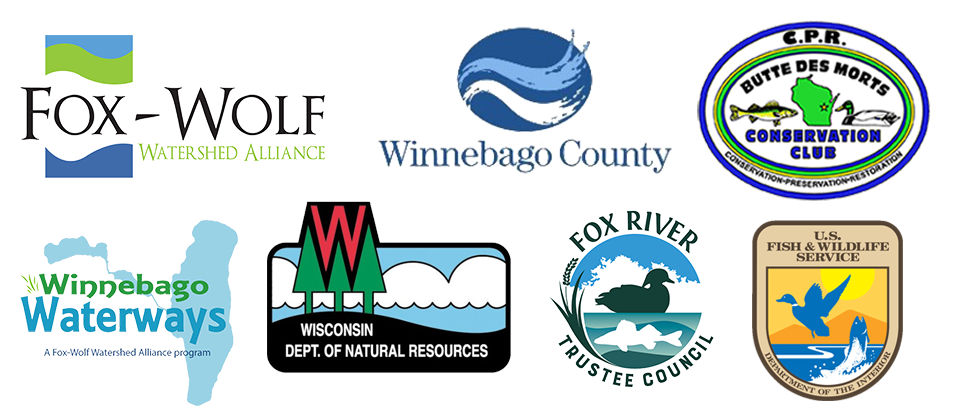
Winnebago Waterways is a Fox-Wolf Watershed Alliance recovery initiative. Contact us at wwinfo@fwwa.org


